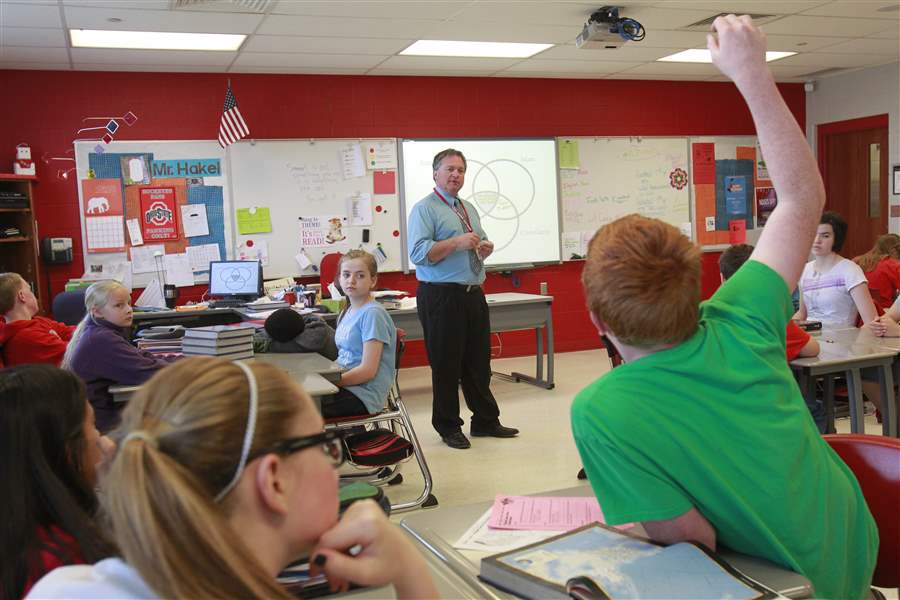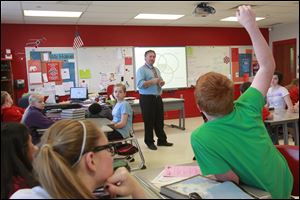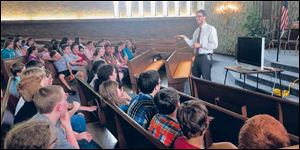
Bowling Green students gain a worldly view
Sixth-graders witness unfamiliar religious practices
5/24/2014
Lane Hakel, a sixth-grade social studies teacher at Bowling Green Middle School, listens to a comment made by Elijah Reinhart, 12.
The Blade/Isaac Hale
Buy This Image

Lane Hakel, a sixth-grade social studies teacher at Bowling Green Middle School, listens to a comment made by Elijah Reinhart, 12.
Social studies teacher Lane Hakel's sixth-grade classes at Bowling Green Middle School visited Perrysburg and Toledo on May 12 for some intentional mixing of church and state on a field trip. They went to a mosque, a church, and a synagogue, and they talked to the religious leaders at each house of worship about the different faiths.
“We got to the mosque [Islamic Center of Greater Toledo, in Perrybsburg] about 9:45 a.m., were there for an hour; drove up to Trinity Episcopal and were there for an hour; we hit Wildwood [Preserve Metropark] for a sack lunch; and then that was right by Congregation Etz Chayim,” Mr. Hakel said.
His 112 students have been studying world religions, with interruptions for weather and other education, since January in their social studies classes. Mr. Hakel said that on the field trip, “I could tell they were listening to what was going on [and] asked relevant questions about what they were seeing around them. Their questions tended to build on what the worship leaders had been saying.”
The next day each class discussed the religions. The talk included Buddhism and Hinduism even though temple visits couldn‘t be squeezed into the trip.
For his 24 fifth-period students, Mr. Hakel started with a Venn diagram of three circles representing Judaism, Christianity, and Islam, the circles partly overlapping to illustrate that the three religions have commonalities while there are other parts of faith not shared. He asked what the three religions have in common.

Lane Hakel, a sixth-grade social studies teacher at Bowling Green Middle School, listens to a comment made by Elijah Reinhart, 12.
“They all believe in one god,” student Emma Grisdale said, and he asked what the big word was that they had learned: “Monotheistic.” He wrote that on the diagram.
“They all started in the Middle East,” said Zachary Nemec.
“Two of them came out of one. ... I think it was Islam and Chrstianity that came out of Judaism,” Elijah Reinhart said.
Alayna Reinhart, Elijah’s sister, said, “They all had one founder.” Students identified Muhammad for Islam and Jesus for Christianity, and after a moment Abraham was mentioned for Judaism.
“All three religions pretty much agree that Abraham was an important person, particularly for the Jewish faith,” Mr. Hakel said.
The students talked about the places of worship they visited and the presentations by Imam Farooq Abo Elzahab and the imam’s son at the mosque, the Rev. Elizabeth Hoster at the church, and Rabbi Jonathan Bienenfeld at the synagogue.
Near the end of the discussion Mr. Hakel asked, “Why do these religions exist?”
Haley Trumbull's response included that people need hope.
Megan Clifford added to the answer, saying, “We all need hope because we all need a reason to live and we all need a reason to think where we're going.”
“You go to the afterlife,” Mackenzie Fleshman said.
“All right,” Mr. Hakel, said, “Mackenzie's touching on a big one, the answer to the question ‘What's next?’ Do all five of these religions answer the question ‘What's next’ in one way or another? They do, don't they?”
Mr. Hakel has been a teacher for 25 years, and most of the time he has taught social studies. “I'm a big separation of church and state guy, and so it's kind of interesting to tread dangerous waters,” Mr. Hakel said. “I tried to keep the kids guessing what religion I was, or if I was.” Like politics, that's personal, he said, but he thought they could guess he's Christian.
Mr. Hakel has cautionary experience about mixing church and state from his student days in the early 1970s. Before the students were in the classroom, Mr. Hakel shared a memory that his second-grade teacher “read to us from the Bible. She was getting in trouble for that and she kept on doing it, and eventually, about three years later, she was fired.”
Mr. Hakel, in contrast, stays within the bounds. “This is comparitive world religions in the sixth-grade Ohio curriculum,” Mr. Hakel said. The state-mandated unit will continue to be taught when Common Core comes into use, he said.
Contact TK Barger @ tkbarger@theblade.com, 419-724-6278 or on Twitter @TK_Barger.